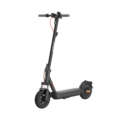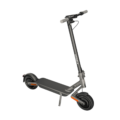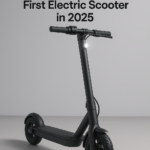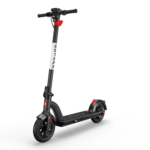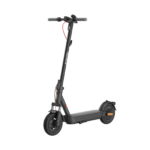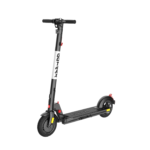- Home
- Scooters
- Electric Scooters
- Xiaomi Electric Scooter 5 Pro
Xiaomi Electric Scooter 5 Pro


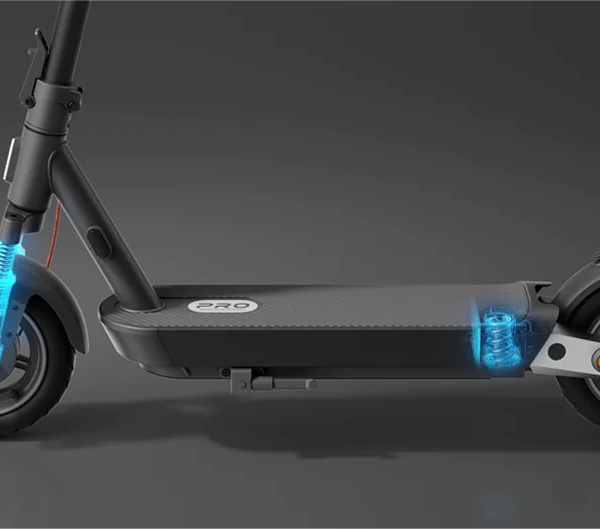
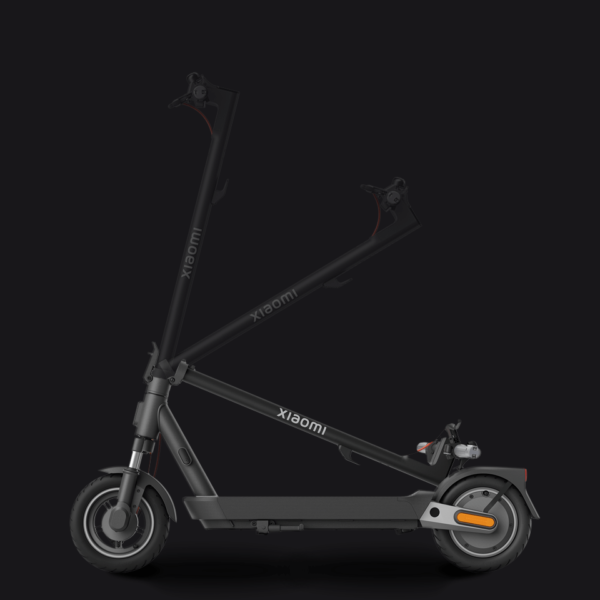
- Battery Range: 60 km
- Top Speed: 25 km/h
- Motor Power: 400 W rated
- Weight Capacity: 120 kg
- Charging Time: 9 hours
- Scooter Weight & Portability: 22.4 kg
PROS
- Front dual-spring + rear single-spring suspension and 10″ tubeless 60 mm tires deliver a calmer ride
- Rear-wheel drive with smooth throttle and adjustable regen
- Integrated indicators, auto headlight, larger tail light, and IPX5 for daily safety
- Carbon-steel frame and quiet 3-step fold feel solid month after month
- Xiaomi Home app with remaining mileage, motor lock, KERS, and updates
CONS
- 25 km/h cap may feel limiting to speed-seekers
- 22.4 kg is heavy for frequent stair carries
- No long-travel rear suspension; comfort still depends on pace and tire pressure

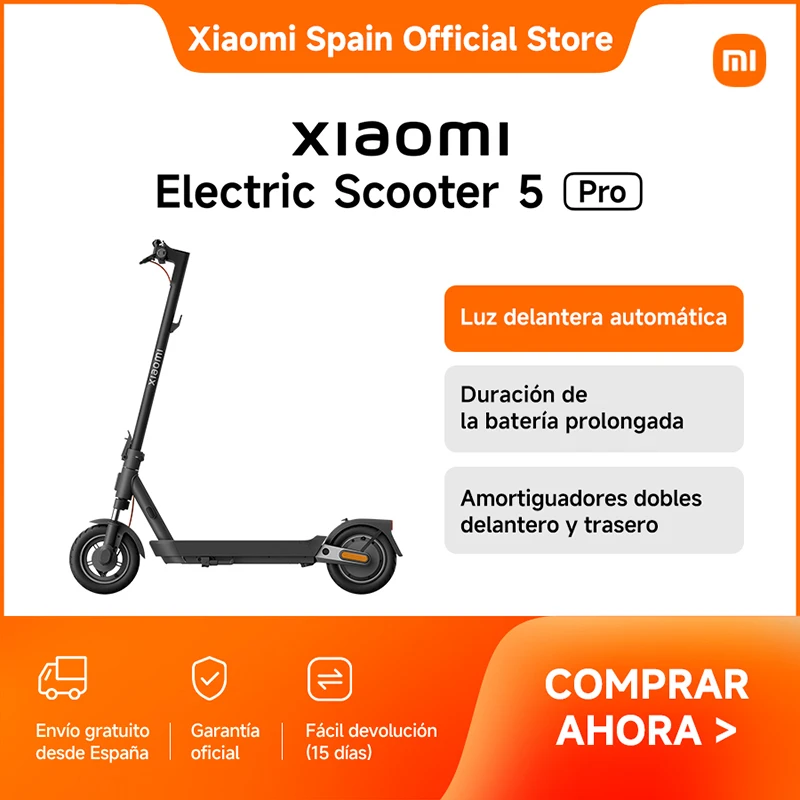

![[Official] Xiaomi Electric Scooter 5 Pro | Front and rear double shock, up to 60 km range, motor 1000 W](https://ae-pic-a1.aliexpress-media.com/kf/S0297f4a96f9a43dba25cfd88c32462aci.jpg)
Introduction: Calm performance, daily wins
The Xiaomi Electric Scooter 5 Pro Specifications describe a commuter that favors poise over flash. First, it delivers steady rear-wheel traction. Second, it cushions sharp edges with practical suspension. Third, it trims ownership friction through simple software. As a result, you get a ride that feels reliable from Monday to Friday. Moreover, it stays composed at city pace. Consequently, you spend less energy wrestling the scooter and more energy reading traffic.
Importantly, nothing here feels gimmicky. The frame uses thick steel to keep the chassis quiet. Meanwhile, the motor sits at the rear to preserve clean steering. Tubeless 10-inch tires resist flats and add real compliance. Additionally, the app puts only the essentials up front. You see remaining mileage, adjust KERS, toggle the auto headlight, and lock the motor. Therefore, setup takes minutes, not evenings. Overall, the package targets practical riders who care more about routine than spectacle.
What the specs deliver in real life
Paper specs can seem abstract; however, the outcomes are easy to feel. A 400 W hub with 1000 W peak gives calm starts and confident climbs. Likewise, a 477 Wh pack supports steady range for short urban loops. Front dual springs and a rear spring remove sting from joints and pavers. Furthermore, tubeless casings reduce pinch-flat risk and smooth tiny chatter.
Beyond that, signaling is unusually clear. Integrated turn indicators live at the grips. Consequently, you can signal without shifting hands. An auto headlight manages dusk once enabled. In addition, a larger tail light brightens under brake and can run constantly. Therefore, drivers and cyclists read your intent sooner. Altogether, the hardware and the safety cues align with real traffic, not just test tracks.
The structure matters too. A three-step fold locks with a firm click. Because of that, play doesn’t creep in as months pass. The steel backbone keeps the stem planted at 25 km/h. Meanwhile, the quiet chassis lets you hear subtle changes. You notice a new rattle early. Thus, small fixes stay small.
Motor behavior: smooth over showy
Power delivery shapes confidence more than raw wattage. Press the thumb throttle and the scooter rolls forward in a steady wave. Then, it holds pace without surges. Consequently, elbows stay neutral and the front end stays calm. Moreover, the rear-drive layout helps on dust and paint. The steering wheel isn’t pulling you; it’s only pointing the way. Therefore, lines stay tidy through paint lines, seams, and grit.
On hills, the tune keeps pressure rather than lunging. You feel a controlled push, not a jerk. Additionally, heat remains moderate because current draw is sensible. Efficiency stays predictable across the route. In Standard mode, the scooter rises to 20 km/h with relaxed cadence. In Sport, it touches the cap briskly yet without drama. Ultimately, control beats theatrics in crowded lanes, and this tune delivers control.
Why rear-wheel drive changes the feel
Rear-wheel drive sounds minor; nevertheless, it transforms handling. Under throttle, weight shifts slightly rearward. Consequently, the contact patch grows just as torque arrives. Slips become rare on typical debris. Meanwhile, the front keeps its only job—steer cleanly. Because of that, corrections feel natural, even when the surface is blotchy.
Braking also benefits from the layout. First, regen engages at the rear when you roll off. Next, the front drum layers in bite as weight transfers forward. Therefore, the chassis stays level and the bars stay steady. Furthermore, steering remains available for tiny edits in the last meters. In short, the sequence is intuitive and forgiving, which is exactly what busy streets demand.
Speed, modes, and urban rhythm
City routes reward rhythm more than raw speed. Accordingly, three modes keep pacing simple. Walking suits promenades and crowded plazas. Standard fits multi-use paths and everyday errands. Sport covers open bike lanes and riverfront sections. A quick double-tap swaps modes. Thus, your eyes remain up, not buried in a menu.
Crucially, the 25 km/h cap aligns with common rules. Consequently, stopping distances shrink, and fatigue falls. The frame feels settled over pavers, not twitchy. Additionally, you conserve energy by avoiding sprint-and-slam habits. In practice, a pattern emerges: ride Standard by default, tap Sport for clear stretches, and drop back before intersections. Therefore, trips stay predictable, and range stretches without anxiety.
Suspension that removes sting, not sensation
Commuters need edge control, not big jumps. The 5 Pro’s dual-spring fork and rear spring aim at that reality. As a result, expansion joints and brick seams feel like pulses, not punches. Moreover, damping keeps geometry stable. The fork moves when it should and stays put when it shouldn’t. Consequently, mid-corner edits feel precise rather than wobbly.
Grip also improves. When the front wheel meets uneven stone, it maintains contact instead of skipping. Thus, traction remains present during trail braking. Shoulders unclench, and wrists relax. Meanwhile, the frame’s steel backbone damps the noise that usually sneaks through light alloy. Ultimately, reduced sting equals better control and clearer decisions.
Tires, pressure, and real-world grip
Tubeless 10-inch tires bring two big wins. First, they reduce flat-related downtime. Second, they shape ride feel for the better. Because the casings carry real volume, the footprint grows and absorbs edges. Therefore, seams become small pulses. Additionally, there’s no inner tube to pinch, so you can run sensible pressures for comfort.
For rough routes, a slightly softer setting adds compliance. For smooth paths, a bit more pressure sharpens roll. Either way, steering stays calm and predictable. Meanwhile, upkeep is simple. Check pressure weekly. Scan the tread for embedded glass. Refresh sealant as needed. Consequently, the scooter remains ready when weather suddenly turns nice on a midweek afternoon.
Braking: sequence, feel, and distance
Safe braking depends on sequence and feel. Roll off the throttle and rear regen begins. Then, pull the lever and the front drum adds linear bite. Therefore, weight shifts forward smoothly rather than suddenly. The chassis stays level, and the bar remains steady. Furthermore, one-finger modulation is easy, so you can scrub speed early without drama.
On wet pavement, that progression matters. The system avoids a harsh initial grab. Consequently, the contact patches stay planted. Stopping distance still depends on speed and surface; however, the 25 km/h cap starts you closer to “stopped.” Over time, you learn earlier roll-off points and rely less on hard lever pulls. Thus, pads last longer, and regen handles more of the work.
Lighting, signaling, and visibility
Visibility is communication. The headlight can switch on automatically after you enable it in the app. Meanwhile, the tail light can run constantly and brightens under brake. Therefore, you gain presence in shade, mist, and dusk. Notably, the indicators sit at the grips. Thumbs trigger them without moving your hands. Consequently, your line stays true while you warn others.
A gentle buzzer reminds you the indicators are active. As a result, you don’t ride a block with a forgotten signal. Reflective elements add side visibility near driveways and parking lots. Together, these cues make your intention readable from all angles. Ultimately, legible intention reduces conflict more than any spec number ever will.
Battery, range planning, and charging habits
Range should feel honest and repeatable. The Xiaomi Electric Scooter 5 Pro Specifications quote about 60 km under set conditions; even so, terrain, wind, and pace shift results. Fortunately, the tune is consistent, so you learn your curve in a week. Additionally, the app shows remaining mileage in plain numbers. Consequently, detours become informed choices rather than gambles.
KERS intensity lets you shape glide. On rolling routes, a higher setting adds gentle engine-brake feel and recovers a bit of energy. On flat paths, a lighter setting lets you coast longer. Meanwhile, charging stays simple. Plug in at night; wake to a full pack. The BMS manages temperature and voltage. Therefore, the cells age gracefully if you avoid extremes. Store indoors, skip long stints at zero, and keep the charge port clean. Thus, performance stays steady across seasons.
Frame, fold, and long-term quiet
Structure determines silence. A carbon-steel backbone boosts torsional stiffness and damps vibration. Accordingly, the stem feels planted at 25 km/h, and the deck rides calm over bricks. Moreover, internal cable routing reduces snag risk in tight hallways. The three-step latch closes with a confident click. Because the contact surfaces are robust, play stays out of the joint.
Folded, the scooter forms a compact rectangle that slips under desks and into hatchbacks. Meanwhile, the kickstand drops to a reliable angle, so parking feels natural. Should a noise appear, you hear it quickly because the rest of the chassis is quiet. Therefore, fixes happen early, before wear spreads. Ultimately, the structure supports low-stress ownership as much as it supports handling.
App experience: fewer taps, more going
Software should reduce friction. Open the app and you see remaining mileage, battery level, and lock status immediately. With one tap, you lock the motor for a quick stop. With another, you unlock and roll away. Consequently, errands feel seamless.
Beyond that, the right toggles sit up front. Enable the auto headlight. Pick a KERS level. Keep the tail light always on if dusk is coming. If needed, ping lights or sound to find the scooter in a crowded rack. When updates arrive, install them without a shop visit. Therefore, you spend less time fiddling and more time moving.
Real-world scenarios: behavior you can count on
Short commutes. Start in Standard and cruise at a calm cadence. Then, tap Sport for an open riverfront stretch. Afterward, ease back before intersections and let regen do early slowing. Consequently, you arrive relaxed and on time.
Errand chains. Tubeless tires shrug off a stray staple outside the market. Meanwhile, the app lock deters casual roll-aways while you grab a parcel. Indicators make storefront passes polite and predictable. Thus, your schedule stays intact.
Mixed surfaces. Tile by the river, pavers through the square, patched asphalt near the station—front springs blunt the sharpest hits, and the rear spring trims tail slap. Additionally, the steel frame damps the lingering hum. Therefore, hands stay fresh and lines stay tidy.
Wet mornings. Reduce speed and brake early. Because regen starts at the rear, weight shifts forward gently. The front drum adds measured bite on a straight line. Meanwhile, the auto headlight glows, the tail stays on, and indicators announce turns in advance. As a result, crosswalks feel controlled rather than abrupt.
Campus days. Long sidewalks and short ramps link buildings. Accordingly, quiet manners suit libraries, and a quick fold handles sudden room changes. Parking threads easily between racks and benches. Ultimately, the scooter feels like a campus tool, not a weekend toy.
Sunday upkeep. Ten minutes covers bolts, pressure, lights, and a wipe-down. If prompted, install a firmware update. Then, set KERS for Monday’s route. Consequently, surprises stay rare.
Ownership costs and simple care
Downtime is the hidden expense; therefore, the design fights it. Tubeless tires cut flat repairs. A rear electronic brake reduces pad wear. The front drum stays consistent in dust and drizzle. Additionally, the fork shields the latch from sharp hits. Together, these choices keep the scooter quiet and available.
Create a short checklist. Monthly, verify axle, stem, and latch fasteners. Weekly, confirm tire pressures and clean the charge port. After wet rides, dry the deck and grips. Periodically, refresh sealant. Consequently, small habits prevent big repairs. Meanwhile, charging on a hard surface with airflow protects the brick and the cord. Thus, the pack and accessories last longer.
Comparisons and buyer fit
Inside Xiaomi’s range, the Xiaomi Electric Scooter 5 Pro Specifications place it above basic commuters that skip suspension and indicators. Accordingly, it rides calmer and communicates clearer. Against high-speed machines, it trades peak numbers for composure and repeatability. In dense cities, that trade serves most riders better than they expect.
Relative to older models, the 5 Pro feels like a mature sequel. Rear-wheel traction steadies lines. Tubeless tires reduce flats. Dual-end suspension removes sting. Moreover, the steel frame stays quiet as mileage grows. The app adds only the toggles that matter. Hence, the scooter focuses on results, not spectacle.
Choose it if you want reliable, comfortable, low-drama transport. Commuters, students, and errand-stackers will appreciate its rhythm. Skip it if you need more than 25 km/h, carry a scooter up several flights daily, or ride rough trails that demand long-travel suspension. Otherwise, this is the sweet spot.
Final verdict: a weekly win
The Xiaomi Electric Scooter 5 Pro Specifications describe a commuter that values clarity. With rear-wheel drive, lines stay clean. With tubeless 10-inch tires, flat delays fade. With front and rear springs, sting disappears without bounce. With a steel backbone and a sturdy fold, the scooter rides quietly month after month. With auto lights and integrated indicators, intent turns into readable signals. Finally, with a focused app, taps drop and trips begin faster.
Consequently, habits improve. Pace becomes predictable. Braking grows earlier and smoother. Attention stretches farther down the lane. Therefore, you arrive on time, with energy left for the day. Ultimately, this isn’t a race scooter. It’s a tool for winning the week—and on that goal, it excels.
Specifications
General
| Model The Model specifies the exact version or name of the scooter. It helps identify its unique design, features, and specifications within the manufacturer’s product line. Knowing the model makes it easier to compare options, find compatible accessories, or look up support information. | Electric Scooter 5 Pro |
| Brand The Brand identifies the manufacturer or company that designs and produces the scooter. A trusted brand is a sign of quality, reliability, and good customer support. Well-known brands often have higher standards for safety, performance, and after-sales service, giving you more confidence in your purchase. | Xiaomi |
| Release Date The Release Date indicates when the scooter model was officially launched on the market. This helps you know how current the design, technology, and features are. A newer release date often means updated components, improved performance, and the latest safety or smart features. | 01 January 2025 |
| Recommended Age Recommended Age indicates the minimum age range that the scooter is designed for, based on safety, size, and ease of use. Following the recommended age helps ensure that riders can handle the scooter’s speed, weight, and controls comfortably and safely. Always check local laws and use protective gear, especially for younger riders. | 16–50 years; recommended rider height 120–200 cm |
Performance & Power
| Motor Power (Wattage) What it means: The motor power, measured in watts (W), shows how strong the scooter’s electric motor is. Why it matters: Higher wattage usually means better acceleration, more torque, and improved performance on hills or rough terrain. For example, a 250W motor is good for flat city roads and light riders, while a 500W or 1000W motor provides more power for faster speeds or climbing steep inclines. | 400 W rated, 1000 W max (rear-wheel drive brushless hub) |
| Top Speed The Top Speed indicates the maximum speed that the scooter can reach under optimal conditions. It’s usually measured on level ground with a fully charged battery and an average rider weight. A higher top speed allows you to travel longer distances faster, but always ensure you ride within legal speed limits and your personal comfort zone for safety. | 25 km/h (Walking 6, Standard 20, Sport 25) |
| Battery Capacity Battery Capacity refers to the total amount of energy the scooter’s battery can store, usually measured in ampere-hours (Ah) or watt-hours (Wh). A higher battery capacity means you can ride longer distances on a single charge, reducing the need for frequent recharging. Keep in mind that actual range can vary depending on rider weight, terrain, speed, and weather conditions. | 10.2 Ah / 477 Wh (48 V system) |
| Estimated Range per Charge The Estimated Range per Charge indicates the average distance the scooter can travel on a single full battery charge. This range is calculated under optimal conditions, such as flat terrain, moderate speed, and average rider weight. Real-world range may vary depending on riding style, terrain, weather, and load. A longer range means fewer recharges and greater freedom for longer trips. | ~60 km (manufacturer test conditions) |
| Hill Climb Ability Hill Climb Ability describes the maximum incline or slope that the scooter can handle while maintaining stable performance. It’s typically expressed as a percentage or in degrees. A higher hill climb rating means the scooter can tackle steeper hills without losing too much speed or power. Actual climbing performance may vary based on rider weight, battery charge, and terrain conditions. | ~22% incline |
| Drive System The Drive System refers to how power from the motor is delivered to the wheels. Electric scooters typically use either a hub motor (directly integrated into the wheel) or a chain/belt drive system. A high-quality drive system ensures smooth acceleration, efficient power transfer, and low maintenance. The choice of drive system affects performance, noise level, and overall ride experience. | Rear-wheel drive |
Charging & Electrical
| Charging Time Charging Time indicates how long it takes to fully recharge the scooter’s battery from empty to 100% using the standard charger provided. Faster charging means less downtime and more time on the road. Actual charging time may vary slightly depending on battery capacity, charger output, and environmental conditions. | ~9 hours (standard charger) |
| Battery Type Battery Type refers to the specific technology used in the scooter’s battery, which affects performance, lifespan, weight, and charging time. Most modern electric scooters use high-quality lithium-ion (Li-ion) batteries because they offer a good balance of energy density, durability, and low maintenance. A reliable battery type ensures consistent power delivery and longer riding ranges. | Lithium-ion with Xiaomi BMS (short-circuit, over-current, over/under-voltage, temperature protections, under-voltage sleep) |
| Removable Battery A Removable Battery means the battery pack can be easily detached from the scooter for convenient charging and replacement. This feature allows you to charge the battery separately, swap it with a spare for extended range, or securely store it indoors in extreme weather. Removable batteries add flexibility and make it easier to keep your scooter powered up wherever you are. | No |
| Regenerative Braking Regenerative Braking is an energy-saving feature that converts some of the energy normally lost during braking back into battery power. When you slow down or brake, the motor works in reverse to generate electricity, which helps extend the scooter’s range and improves overall efficiency. This system also reduces wear on traditional brake components, leading to lower maintenance over time. | Yes |
| Lighting Lighting refers to the built-in front and rear lights that enhance visibility and safety when riding in low-light conditions or at night. Good lighting helps you see the road ahead and ensures that other road users can see you. Many scooters include LED headlights, taillights, and sometimes brake lights or side reflectors for added safety and compliance with local traffic regulations. | Auto headlight, larger tail light (always-on option), integrated turn indicators with buzzer alert |
Build & Dimensions
| Scooter Weight Scooter Weight refers to the total weight of the scooter when fully assembled, including the battery. This affects how easy it is to carry, lift, and store the scooter when not in use. A lighter scooter is more portable and convenient for commuting, especially if you need to carry it upstairs or onto public transport. Keep in mind that a sturdy frame and quality components may add to the weight but also contribute to better durability and ride stability. | 22.4 kg |
| Maximum Rider Weight Maximum Rider Weight indicates the highest rider weight that the scooter is designed to safely support while maintaining optimal performance and stability. Staying within this limit helps ensure reliable acceleration, braking, and climbing ability, and it protects the frame, suspension, and motor from excessive strain. Exceeding the recommended limit may reduce performance and increase wear on components. | 120 kg |
| Deck Size Deck Size refers to the dimensions of the scooter’s standing platform. A wider and longer deck provides more foot space, allowing you to stand comfortably and adjust your stance while riding. A well-sized deck improves balance and stability, especially on longer rides or at higher speeds. Compact decks, on the other hand, help keep the scooter lightweight and portable. | Not specified by manufacturer (wider deck noted) |
| Handlebar Height Handlebar Height refers to the distance from the deck to the handlebars, which affects your riding posture and comfort. An appropriate handlebar height helps you maintain good balance, reduces strain on your back and arms, and makes steering more comfortable. Some scooters have adjustable handlebars to fit riders of different heights, while others have a fixed height for a streamlined design. | 1271 mm overall height (unfolded) |
| Folding Mechanism The Folding Mechanism describes how easily and securely the scooter can be folded for carrying and storage. A well-designed folding system lets you quickly collapse the scooter into a compact size, making it convenient to transport on public transit, store under a desk, or fit into a car trunk. Look for sturdy latches and safety locks to ensure the scooter stays firmly in place when folded or unfolded. | Yes |
| Dimensions Folded Dimensions indicate the size of the scooter when it’s fully folded. This measurement shows how much space the scooter will take up when stored or carried, making it easier to check if it will fit in your car trunk, under a desk, or in a closet. Compact folded dimensions are ideal for commuters who need to bring their scooter on public transport or store it in tight spaces. | 1192 × 565 × 584 mm (L × W × H) (official dimensions image) |
| Material Material refers to the primary construction materials used for the scooter’s frame and key components. High-quality materials like aircraft-grade aluminum, reinforced steel, or durable composites provide strength, stability, and a lighter overall weight. A sturdy material ensures the scooter can handle daily wear and tear while maintaining safety and performance. | 1.5 mm thick high-strength carbon steel frame; concealed wiring |
Safety & Control
| Brake Type(s) Brake Type(s) describe the braking systems the scooter uses to help you slow down or stop safely. Common brake types include mechanical brakes (like drum or disc brakes), electronic brakes, and foot brakes. Many scooters combine multiple braking systems for added safety and shorter stopping distances. The type and quality of brakes affect your control, especially when riding at higher speeds or on slopes. | Dual-brake: front drum + rear E-ABS (electronic) |
| Suspension Suspension refers to the system that absorbs shocks and vibrations while riding, providing a smoother and more comfortable ride over uneven or rough surfaces. Scooters may have front suspension, rear suspension, or dual suspension for better shock absorption and stability. Good suspension helps reduce rider fatigue and improves control, especially when riding on bumpy roads or off-road paths. | Front dual-spring + rear single-spring shock absorbers |
| Tire Type Tire Type refers to the kind of tires the scooter uses, which directly affects ride comfort, traction, and maintenance. Common types include solid (airless) tires, pneumatic (air-filled) tires, or hybrid options. Pneumatic tires offer better shock absorption and a smoother ride on rough surfaces, while solid tires are puncture-proof and require less upkeep. The right tire type helps ensure safe handling and a comfortable ride in different conditions. | Tubeless, puncture-resistant design (energy-absorbing) |
| Tire Size Tire Size indicates the diameter and width of the scooter’s tires, which affect ride comfort, stability, and how well the scooter handles different terrains. Larger tires generally offer better shock absorption and a smoother ride over bumps and rough surfaces, while smaller tires keep the scooter lighter and more portable. Choosing the right tire size helps ensure a balance between agility and comfort. | 10″ × 60 mm (front & rear) |
| Kickstand The Kickstand is a built-in stand that allows you to park your scooter upright when it’s not in use. A sturdy kickstand keeps the scooter stable and prevents it from tipping over, protecting it from scratches and damage. It also makes storing and accessing your scooter more convenient, whether you’re at home, work, or on the go. | Yes |
| Water Resistance Rating Water Resistance Rating indicates how well the scooter is protected against water and moisture, usually shown as an IP (Ingress Protection) rating. This rating helps you understand whether the scooter can handle light rain, splashes, or wet roads without damage. While most scooters are not fully waterproof, a good water resistance rating adds peace of mind when riding in changing weather conditions. Always avoid deep puddles or submerging the scooter to protect its electrical components. | IPX5 |
Features & Extras
| Display/Console The Display (or Console) shows important real-time information about your ride, helping you monitor your scooter’s status at a glance. Typical displays show speed, battery level, distance traveled, and riding mode. Some models also include additional features like Bluetooth connectivity, app integration, or backlighting for better visibility at night. A clear and easy-to-read display enhances safety and convenience on every trip. | Multi-functional dashboard (speed, battery, status, indicators) |
| Ride Modes Ride Modes refer to the different speed and power settings you can choose to match your riding style or road conditions. Common modes include eco for maximum range and energy efficiency, standard for everyday balance, and sport or turbo for higher speed and stronger acceleration. Switching between ride modes allows you to customize performance, conserve battery, and ride safely in various environments. | 3: Walking, Standard, Sport (double-tap to switch) |
| Smart App Connectivity Smart App Connectivity lets you pair your scooter with a dedicated mobile app via Bluetooth. Using the app, you can monitor real-time ride stats like speed, battery level, and range, adjust settings such as ride modes or cruise control, lock the scooter for added security, and sometimes receive firmware updates. This feature adds convenience and allows you to personalize your riding experience right from your smartphone. | Xiaomi Home / Mi Home: remaining mileage, battery info, motor lock, firmware updates, auto-light, KERS intensity, find-my-scooter light/sound ping |
| Anti-Theft System The Anti-Theft System helps protect your scooter from unauthorized use or theft. This feature can include built-in alarms, electronic motor locks, GPS tracking, or remote locking through a mobile app. A good anti-theft system provides peace of mind when parking your scooter in public spaces, adding an extra layer of security to safeguard your investment. | App motor lock (deterrence) |
| Cruise Control Cruise Control allows you to maintain a steady speed without continuously holding the throttle. This feature makes longer rides more comfortable by reducing hand fatigue and providing a smoother, more relaxed riding experience — especially on flat, open roads or bike lanes. For safety, cruise control can usually be easily activated or deactivated while riding. | Yes |
| Accessories Included Accessories Included lists the additional items that come with the scooter to enhance your riding experience and convenience. Common accessories may include a charger, kickstand, bell, lights, phone holder, or carrying strap. These extras add value by making your scooter safer, easier to use, and ready to ride straight out of the box. | Power adapter, T-handle Allen key, screws, user manual |
Warranty & Compliance
| Warranty Period The Warranty Period indicates how long the manufacturer guarantees the scooter against defects in materials and workmanship under normal use. A good warranty provides peace of mind, showing the brand’s confidence in its product quality. Always check what parts are covered, such as the frame, battery, and motor, and follow the maintenance guidelines to keep your warranty valid. | Region-dependent (often up to 2 years under local consumer law) |
| Certifications Certifications confirm that the scooter meets specific safety, quality, and environmental standards set by recognized organizations or regulatory bodies. Common certifications may include CE, RoHS, UL, or other local compliance marks, depending on your region. These certifications ensure that the scooter is manufactured to high standards and is safe and legal to use in your country. | IPX5 ingress rating; E-mark indicators; EN17128 speed-mode references on Xiaomi pages |
Price Comparison



![[Official] Xiaomi Electric Scooter 5 Pro | Front and rear double shock, up to 60 km range, motor 1000 W](https://ae-pic-a1.aliexpress-media.com/kf/S0297f4a96f9a43dba25cfd88c32462aci.jpg)



